calsfoundation@cals.org
Bauxite Mining
Bauxite is the principal ore of aluminum and is a mixture of aluminum oxides and hydroxides that formed from intense chemical weathering of a soil in tropical environments. Soils formed under these conditions are termed laterites. In Arkansas, the aluminum-enriched soils are the result of the decomposition and lateritic weathering of nepheline syenite, an intrusive igneous rock. During the weathering process, leaching by rain, groundwater, and salt spray decomposed the original syenite minerals (feldspar and nepheline). Weathering removed much of the silica and concentrated the newly formed aluminum oxides and hydroxides as the rock termed bauxite. Geologically, the soils formed from syenite and weathered to laterites in the Paleocene Epoch (65–55 million years ago) along the west edge of a shallow marine basin that occupied the present Mississippi River Embayment in the central portion of the state. In the Eocene Epoch (55–34 million years ago), some of the bauxite deposits were stripped from where they originally formed and were deposited by freshwater streams in valleys and on the sides of topographically high areas in the Wilcox Group. Thus, there are two types of deposits recognized in Arkansas: in-situ (in place) and transported. Both have been economically important. In-situ deposits lie in blanket form on top of the original igneous rock, whereas transported bauxite deposits are generally smaller and resemble a wedge, with the earlier topography determining the base of the deposit. Transported bauxite contains cobblestones and boulders of bauxite set in fine-grained bauxite matrix.
Mining and Geology
The Arkansas bauxite region covers about 275 square miles in the northern part of the West Gulf Coastal Plain and is divided into two mining districts. One area is in Pulaski County, south and east of Little Rock, and the other is in nearby Saline County, northeast and east of Benton.
Many of the early-mined Arkansas bauxite deposits were exposed on the surface as outcrops or were beneath only a thin layer of sedimentary cover. Consequently, surface-mining methods were initially the most practical and economical. Before and during World War II, significant tonnages were mined underground. Some years after the war, surface operations resumed. Open-pit panel mining has been the normal surface method since the early 1960s. A strip or block of bauxite is exposed and mined, and then another panel is exposed. The first panel is normally refilled with waste rock. Several panels typically were open at the same time to supply the proper blend of ores to meet mill specifications. Beginning in the early 1990s, major reclamation programs were begun to restore not only the recently mined land but much of the land that was disturbed before reclamation laws went into effect.
Discovery and Production
Bauxite in Arkansas was described in 1842 by Dr. W. Byrd Powell, who noted the peculiar character of this rock in Fourche Cove, now the Granite Mountain area of Pulaski County, but did not recognize its true nature. Bauxite was first mined in Arkansas as an ore of metallic aluminum in 1896, only nine years after John C. Branner, the state geologist, first identified it in a sample from Pulaski County. During the twentieth century, Arkansas provided about ninety percent of all domestic tonnage mined. There was even a created Mississippi River port called Bauxippi (Crittenden County) for the transportation of the ore. As aluminum became more widely available, many new uses of the metal (and of the by-products of the aluminum industry) were discovered, and consumption increased rapidly. Tonnages of bauxite mined in Arkansas increased much more slowly than U.S. national consumption because larger deposits supplying higher-grade bauxite were readily available in the Caribbean region. In the early stages of World War II, merchant freighters carrying bauxite to the United States suffered major losses to enemy submarines. The tonnage of bauxite mined in Arkansas quickly increased to meet wartime demands for aluminum, which was especially critical to the military aircraft industry. During the war, the federal government essentially controlled national production of certain strategic and critical minerals like bauxite. In 1943, more than 6 million long tons (2,240 pounds/longton) of bauxite were mined. Due to changes in both domestic and world economic market conditions, 1982 was the last year in which bauxite was mined in Arkansas for aluminum metal. Small tonnages continue to be mined and used in the production of a variety of alumina-based materials, including various chemicals, abrasives, and propants—high-density spherical grains that are used in the oil and gas industry to fracture formations and maximize gas or oil flow.
Two international companies continued major mining operations in the bauxite area following the end of World War II: Alcoa Mining Company and Reynolds Metals Company. However, early in 1982, the Reynolds Company closed and disassembled its Hurricane Creek Plant; the former operated the company-run town of Bauxite (Saline County) from the early 1900s until 1969. Alcoa’s chemical facility remains in production as of 2009, operating with imported bauxite. Several other companies have been active in Arkansas bauxite production and usage: American Cyanamid Company, Norton Company, Porocel Corporation, Stauffer Chemical Company, and A. P. Green Company. Between the end of World War II and the early 1980s, annual production averaged nearly 1.7 million long tons of bauxite. Since 1996, McGeorge Contracting Co., based in Little Rock, has been custom mining bauxite for non-metal uses.
Bauxite is a non-renewable resource that has directly added significantly to the economic development of Arkansas, both directly and through associated industries and suppliers. Best approximation of total bauxite production from 1898 to 2009 is 110 million long tons, valued at an estimated $1 billion.
For additional information:
Bramlette, M. N. Geology of the Arkansas Bauxite Region. Little Rock: Arkansas Geological Survey, 1936.
Gendron, Robin S., Mats Ingulstad, and Espen Storli. Aluminum Ore: The Political Economy of the Global Bauxite Industry. Vancouver: UBC Press, 2013.
“History of Bauxite in Arkansas.” Arkansas Geological Survey. https://www.geology.arkansas.gov/docs/pdf/education/Bauxite.pdf (accessed April 12, 2022).
“Metallic Minerals.” Arkansas Geological Survey. https://www.geology.arkansas.gov/minerals/metallic-minerals.html (accessed April 12, 2022).
Stroud, R. B., R. H. Arndt, F. B. Fulkerson, and W. G. Diamond. Mineral and Mineral Industries of Arkansas. Bulletin 645. Washington DC: US Bureau of Mines, 1969.
J. Michael Howard
Mabelvale, Arkansas
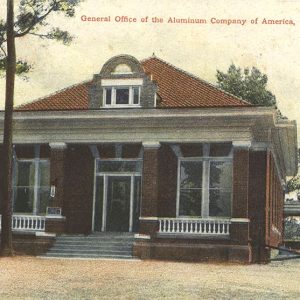 Aluminum Company of America
Aluminum Company of America 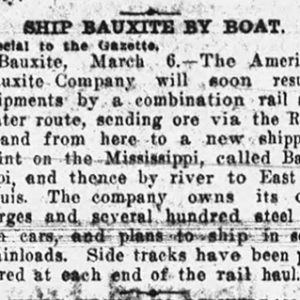 Bauxippi Article
Bauxippi Article 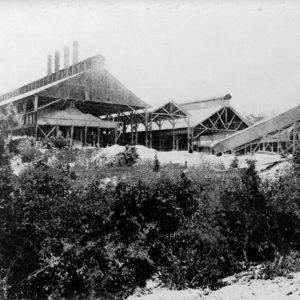 Bauxite Mill
Bauxite Mill 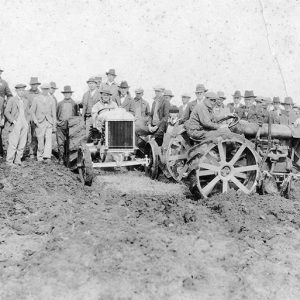 Bauxite Miners
Bauxite Miners  Bauxite Mining
Bauxite Mining  Bauxite Mural
Bauxite Mural 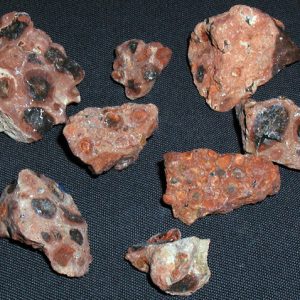 Bauxite, Official State Rock
Bauxite, Official State Rock  John Casper Branner
John Casper Branner 




Comments
No comments on this entry yet.